In a product-led growth (PLG) model, the product itself is the primary driver of user acquisition, conversion, and expansion. Instead of relying solely on traditional marketing and sales funnels, a PLG strategy leverages the product experience to create a self-serving flywheel where users discover value, adopt features, and ultimately become paying customers. This approach puts the user experience front and center, transforming your software from a simple solution into your most effective marketing and sales channel. To truly understand the impact and application of this strategy, dive into some powerful product-led growth examples.
However, executing a successful PLG strategy requires more than just a great product; it demands a specific set of tools designed to understand user behavior, guide users to value, and iterate on the product experience. The right product led growth tools provide the critical infrastructure for this model to thrive. They help you answer essential questions like:
- Which features are driving activation and retention?
- Where are users getting stuck in their journey?
- How can we effectively onboard new users without manual intervention?
- Which user segments are most likely to upgrade?
This comprehensive guide is designed to help you navigate the complex landscape of PLG software. We've curated a list of the top tools across key categories, including product analytics, user onboarding, and feature flagging. For each tool, you'll find a detailed analysis of its core features, ideal use cases, pros, cons, and pricing structure, complete with screenshots and direct links. Our goal is to provide a practical resource that helps you move beyond generic feature lists and select the right stack to power your growth.
1. Refgrow
Refgrow stands out as a premier choice for SaaS businesses aiming to bake affiliate marketing directly into their product experience. It's a cutting-edge platform designed to launch a fully native, embeddable affiliate dashboard inside your application with just a single line of code. This approach eliminates the jarring user experience of redirecting potential advocates to external portals, a common friction point that kills conversion rates and undermines a seamless product-led growth strategy.

What truly distinguishes Refgrow is its commitment to scalability and fairness. Unlike competitors that penalize growth with revenue caps or high commission fees, Refgrow offers unlimited affiliate earnings with a 0% platform commission. This model is particularly powerful for high-growth SaaS companies that need predictable costs. Its built-in Referral Exchange is another significant advantage, instantly connecting businesses to a pre-vetted network of over 100 SaaS affiliates, which dramatically shortens the time to activate a productive partner program. For a deeper dive into this approach, you can learn more about how Refgrow supports a product-led growth strategy on their blog.
Key Strengths and Use Cases
- Seamless Integration: Ideal for product teams wanting to maintain brand consistency. The white-label, customizable dashboard feels like a native part of your app, not a third-party add-on.
- Accelerated Partner Acquisition: Perfect for startups needing to build a partner channel quickly. The Referral Exchange provides immediate access to active promoters without manual outreach.
- Developer-Friendly Control: With a REST API and webhook integrations for Stripe and LemonSqueezy, engineering teams can automate workflows and build custom solutions.
- Global Scalability: Multi-language support and flexible commission structures (percentage, fixed, or recurring) make it suitable for businesses targeting international markets.
Pricing and Technical Details
- Pricing: Plans start from an accessible $9 to $19 per month.
- Pros:
- True native in-app experience.
- 0% platform commission on unlimited earnings.
- Instant access to a SaaS affiliate network.
- Advanced customization and developer tools.
- Cons:
- The entry price point may be higher than basic tools for microbusinesses.
- Maximizing advanced features like the REST API requires some technical expertise.
Website: https://refgrow.com
2. Amplitude
Amplitude is a comprehensive product analytics and digital optimization suite designed to help teams understand user behavior, ship features faster, and personalize experiences. It centralizes product analytics, experimentation, feature flags, and session replay into a single, unified platform. This integration makes it a powerhouse among product led growth tools, as it eliminates the need to stitch together multiple disparate systems.
The platform excels at providing deep insights into the entire customer journey. Teams can move beyond simple page views to analyze complex user paths, build behavioral cohorts, and measure the true drivers of retention and conversion. This granular view is essential for PLG motions that rely on understanding exactly how users find value and progress towards activation.
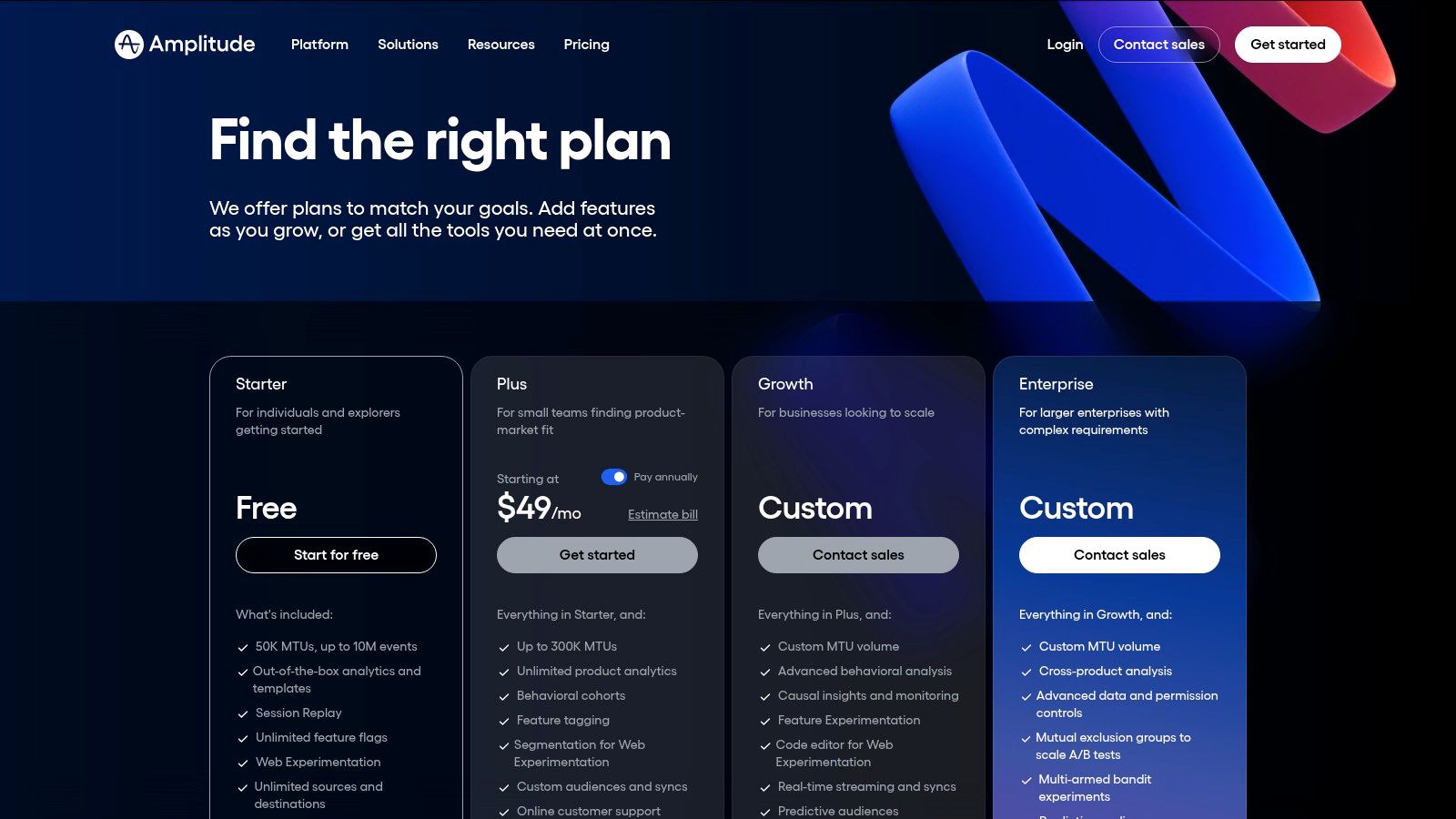
Why It's a Top PLG Tool
Amplitude's strength lies in its ability to connect product data directly to business outcomes. For instance, a product manager can identify a drop-off point in a user onboarding funnel, create a hypothesis for a fix, and then use Amplitude's built-in A/B testing and feature flags to roll out a change to a specific segment of users. The impact of that change is then measured within the same tool, creating a tight feedback loop.
Key Features & Pricing
| Feature | Description | Availability |
|---|---|---|
| Product Analytics | Deep behavioral analytics including funnels, cohorts, retention, and user paths. | Free & Paid Plans |
| Experimentation | Integrated A/B testing and experimentation tools to validate hypotheses. | Paid Plans |
| Feature Flags | Safely roll out and manage new features with targeted releases. | Paid Plans |
| Session Replay | Visually replay user sessions to understand their experience and debug issues. | Paid Plans |
- Pros: Its generous free tier is a huge advantage for early-stage startups. The platform is built to scale from small teams to large enterprises without requiring a re-platform.
- Cons: The event-based pricing model, which relies on Monthly Tracked Users (MTUs), can be initially confusing to forecast. Advanced features are gated behind paid tiers.
For teams looking to take their data a step further, Amplitude's capabilities are a natural fit for creating powerful customer-facing dashboards. Explore the possibilities with embedded analytics for your SaaS platform to see how you can surface product insights directly to your users.
Website: https://www.amplitude.com/
3. Mixpanel
Mixpanel is a powerful, event-based product analytics platform designed to provide fast, self-serve insights into user behavior. It helps teams understand how users engage with their products by tracking actions rather than page views, enabling a deeper analysis of the entire customer journey. This focus on user actions makes it an essential tool for companies building their product led growth tools stack.
The platform is renowned for its user-friendly interface, which empowers non-technical team members, like product managers and marketers, to answer complex questions without writing SQL. Teams can easily build funnels, analyze retention, and visualize user flows to identify friction points and opportunities for growth. This accessibility democratizes data and accelerates decision-making.
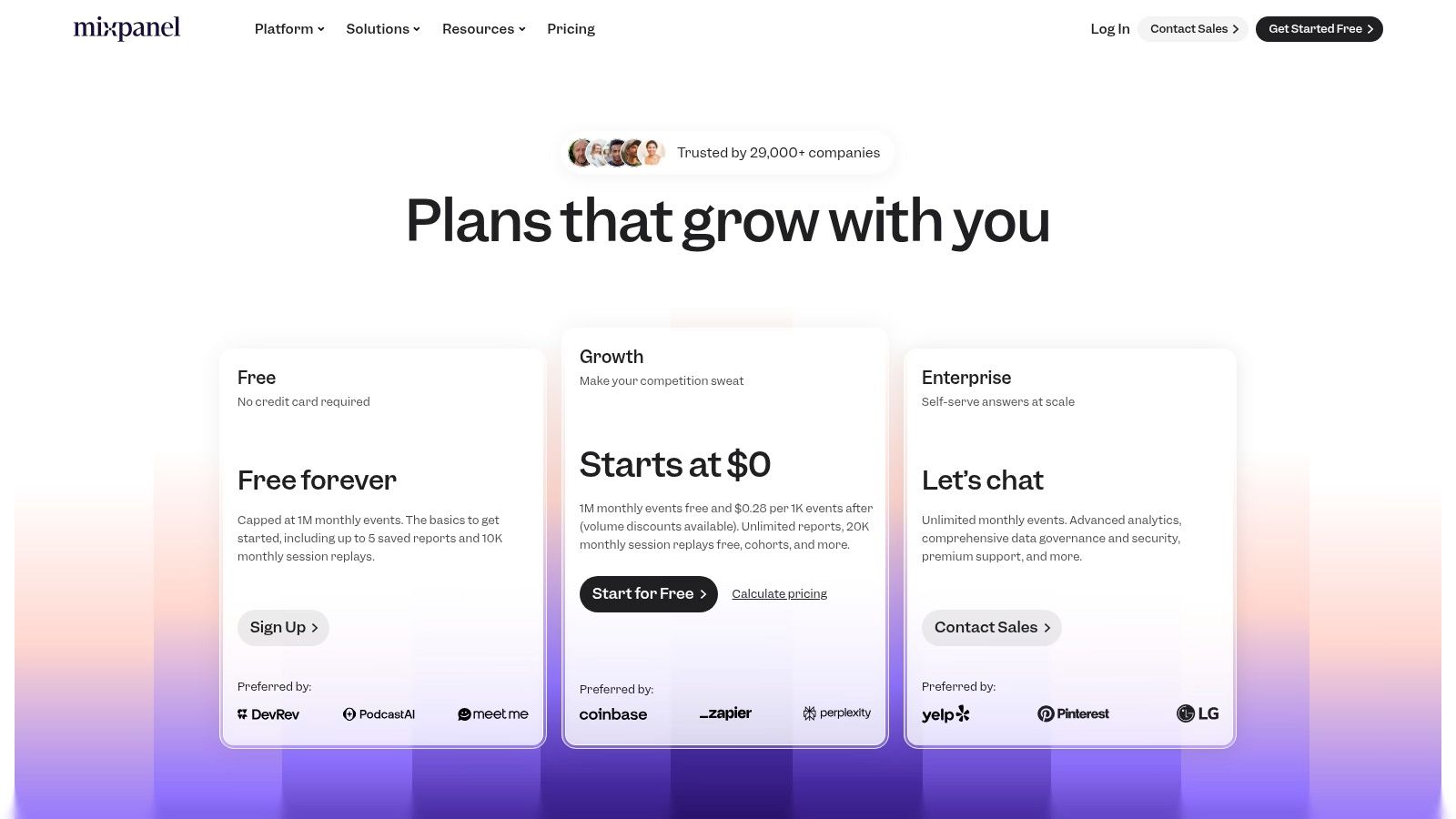
Why It's a Top PLG Tool
Mixpanel’s strength lies in its speed and simplicity for core PLG analytics. A growth team can quickly identify which user behaviors correlate with long-term retention, create a behavioral cohort of these "power users," and then analyze their distinct paths through the product. With features like Spark AI, users can ask questions in plain language and get instant reports, dramatically shortening the feedback loop between inquiry and insight.
Key Features & Pricing
| Feature | Description | Availability |
|---|---|---|
| Event-Based Analytics | Track specific user actions to build funnels, flows, and retention reports. | Free & Paid Plans |
| Templates | Pre-built report templates for common PLG use cases like activation and engagement. | Free & Paid Plans |
| Spark AI | An AI-powered assistant that builds reports from natural language queries. | Paid Plans |
| Session Replay | Watch video-like replays of user sessions to understand their experience. | Bundled in Paid Plans |
- Pros: Its transparent, event-based pricing includes a generous free tier of up to one million monthly events. The user experience is excellent for non-analysts, making data accessible across the organization.
- Cons: Costs can escalate quickly for products with high event volume. More complex statistical modeling might still require support from a data engineering team.
Mixpanel is ideal for teams that need to move fast and empower everyone to make data-informed product decisions without a steep learning curve.
Website: https://mixpanel.com/pricing?utm_source=openai
4. PostHog
PostHog is an open-source product operating system that consolidates a wide array of tools into one platform. It combines product analytics, session replay, feature flags, A/B testing, surveys, and even a data warehouse into a single, cohesive solution. This all-in-one approach makes it a standout choice for teams looking to reduce vendor complexity and centralize their product led growth tools.
The platform is built with developers in mind and offers both cloud and self-hosted options, giving teams complete control over their data. By unifying previously separate functions, PostHog allows product teams to move from identifying a user behavior pattern in analytics to replaying a session for context, and then deploying a feature flag to test a solution, all without leaving the platform.
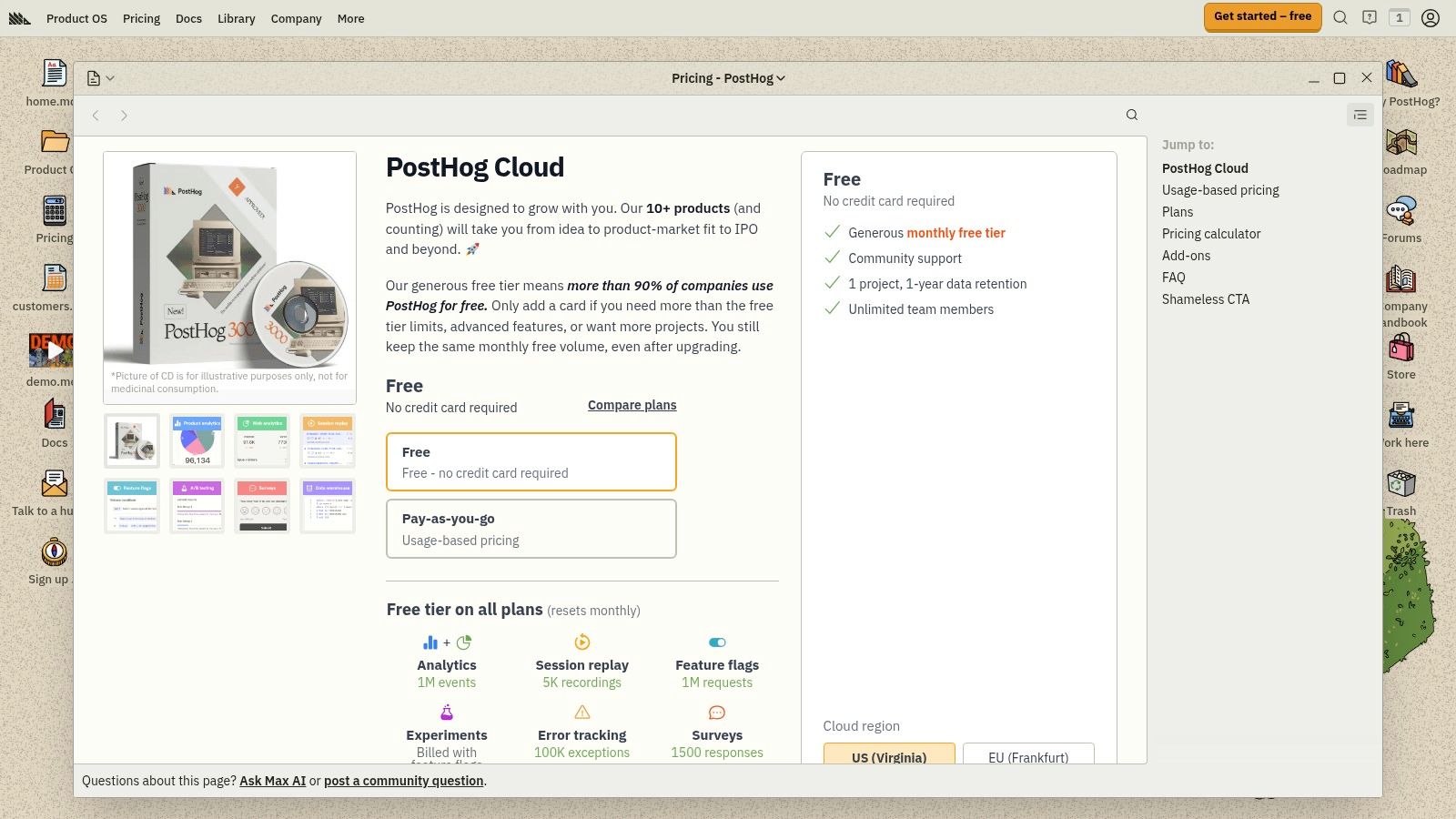
Why It's a Top PLG Tool
PostHog’s primary strength is its integrated, open-source nature. It empowers teams to own their entire product data stack, avoiding data silos and vendor lock-in. For a PLG motion, this means having a unified view of the user journey, from initial acquisition analytics to in-product engagement and experimentation. The ability to self-host provides unparalleled data privacy and control, which is a critical consideration for many companies.
Key Features & Pricing
| Feature | Description | Availability |
|---|---|---|
| Product Analytics | Track events, create funnels, build cohorts, and analyze user retention. | Free & Paid Plans |
| Session Replay | Watch recordings of user sessions to understand their behavior and identify bugs. | Free & Paid Plans |
| Feature Flags & A/B Testing | Roll out features to specific user segments and run experiments. | Free & Paid Plans |
| Surveys | Collect qualitative feedback directly from users within your product. | Free & Paid Plans |
- Pros: The platform's free tiers are incredibly generous, making it accessible for startups. Its all-in-one design significantly reduces vendor sprawl and simplifies the tech stack.
- Cons: The sheer breadth of features can present a steep learning curve for new teams. While initial tiers are generous, costs can scale quickly with very high event volume.
Website: https://posthog.com/pricing?utm_source=openai
5. Pendo
Pendo is a comprehensive product experience platform that combines in-app guides, user analytics, and feedback tools into a single solution. It is designed to help product teams understand user behavior, guide customers through their journey, and gather feedback without ever requiring them to leave the application. This unified approach makes it a powerful asset for companies implementing product led growth strategies, as it connects product usage directly to user engagement and sentiment.
The platform enables teams to create codeless in-app guides, tooltips, and announcements, which are crucial for effective user onboarding and feature adoption. By analyzing how users interact with the product and collecting direct feedback through NPS surveys, teams can continuously iterate and improve the customer experience. This creates a powerful loop of insight, action, and measurement all within one system.
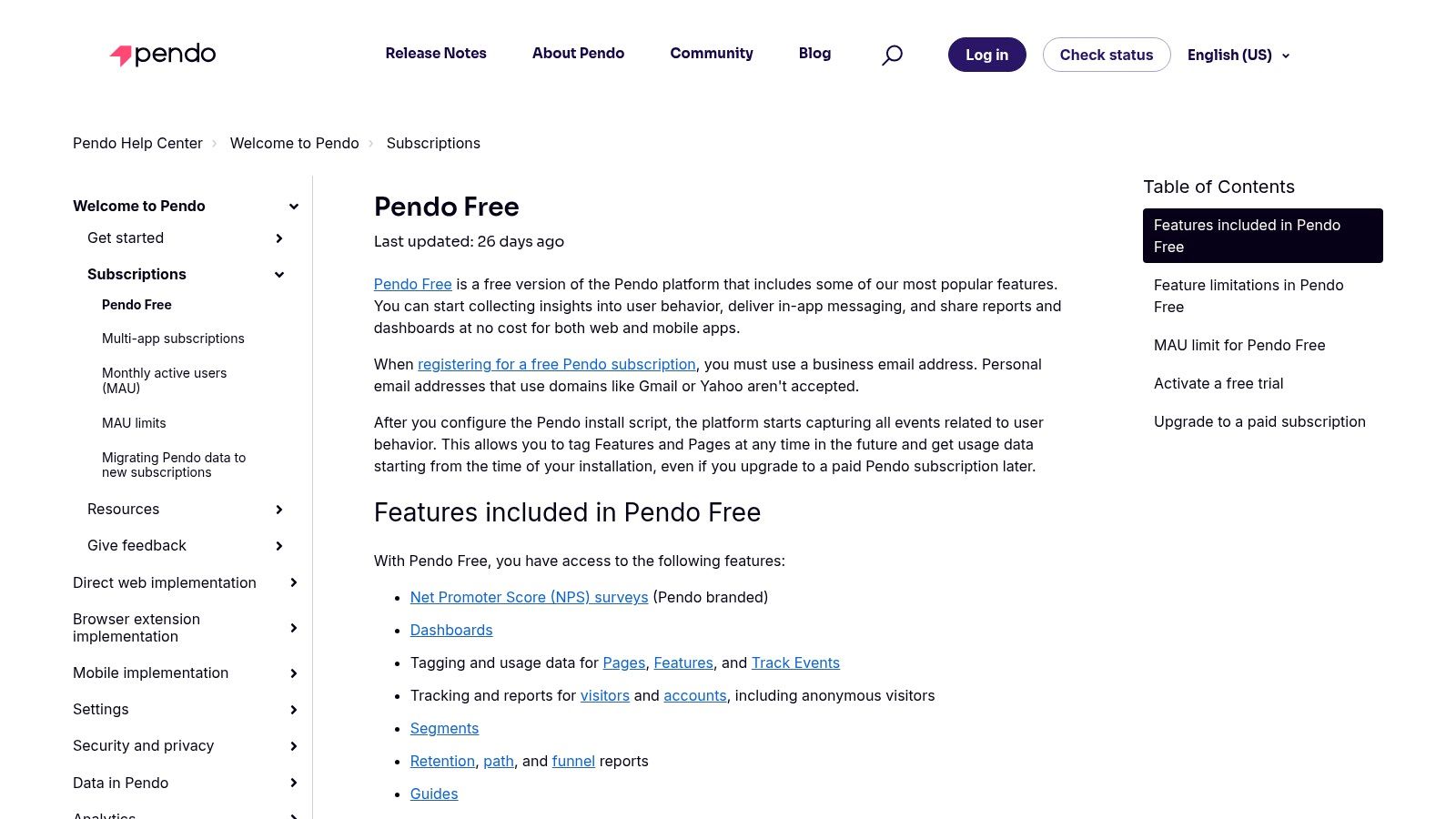
Why It's a Top PLG Tool
Pendo’s core strength is its ability to blend quantitative analytics with qualitative engagement. A product team can identify a feature with low adoption rates using Pendo's analytics, then immediately deploy an in-app guide targeted at the specific user segment that is struggling. This direct intervention helps users discover value on their own, a fundamental principle of PLG. The ability to act on data without waiting for engineering resources accelerates the entire product development cycle.
Key Features & Pricing
| Feature | Description | Availability |
|---|---|---|
| In-app Guides | No-code tool for creating walkthroughs, tooltips, and resource centers. | Free & Paid Plans |
| Product Analytics | Track user behavior, feature adoption, and create funnels and paths. | Free & Paid Plans |
| NPS & Surveys | Collect user sentiment and feedback directly within the application. | Free & Paid Plans |
| Mobile SDKs | Extend product experience capabilities to native mobile applications. | Paid Plans |
- Pros: Its combination of analytics and in-app engagement in one platform is a major advantage for onboarding at scale. It also offers strong enterprise governance options for larger teams.
- Cons: The free plan is quite limited, capped at 500 Monthly Active Users (MAU). Pricing for paid plans is quote-based and not publicly listed, which can be a hurdle for smaller teams.
Website: https://support.pendo.io/hc/en-us/articles/6069107464091-Pendo-Free?utm_source=openai
6. Appcues
Appcues is a powerful no-code platform designed for creating in-app user experiences that drive product adoption. It allows non-technical teams to build, manage, and experiment with user onboarding flows, feature announcements, and feedback surveys without writing a single line of code. This focus on empowering product and marketing teams makes it an essential tool for executing product-led growth strategies.
The platform specializes in guiding users to their "aha!" moment faster through contextual, personalized in-product communication. Instead of static tours, teams can build dynamic experiences like interactive walkthroughs, checklists, and tooltips that respond to user behavior. This capability is critical for PLG, as it helps activate new users and encourages deeper engagement with key features.
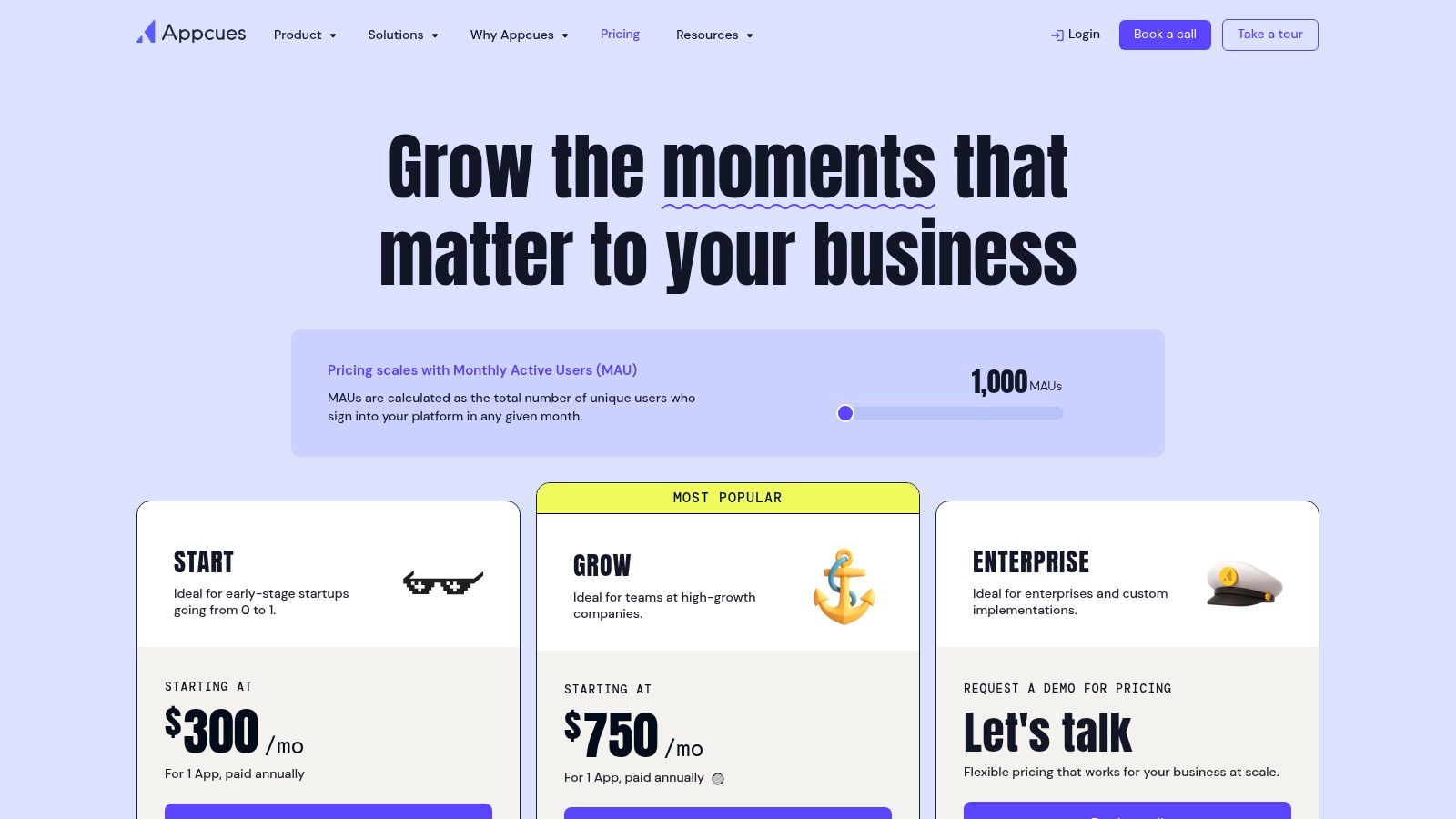
Why It's a Top PLG Tool
Appcues' strength is its ability to directly influence user behavior within the product itself. For example, a product manager can use its advanced segmentation to target a group of users who haven't adopted a new feature. They can then deploy a slideout or tooltip to highlight the feature's value at the exact moment the user might need it, directly boosting adoption rates and demonstrating value.
Key Features & Pricing
| Feature | Description | Availability |
|---|---|---|
| In-App Experiences | Build modals, slideouts, tooltips, checklists, and banners with a no-code editor. | All Plans |
| Targeting & Segmentation | Deliver experiences to specific user segments based on properties or in-app events. | All Plans |
| A/B Testing | Experiment with different in-app flows and messaging to optimize for activation. | Growth & Enterprise Plans |
| Compliance & Security | SOC 2 and HIPAA options are available for organizations with strict data requirements. | Enterprise Plan |
- Pros: It's incredibly fast to implement for product-led onboarding. The platform offers strong targeting controls and a polished user experience.
- Cons: Pricing isn't fully public and is based on MAUs, often requiring a sales conversation to get started on a paid plan.
For teams dedicated to creating a seamless initial user journey, Appcues provides the tools to build and refine that critical first impression. To explore this topic further, discover some key SaaS onboarding best practices that can be implemented using tools like this.
Website: https://www.appcues.com/
7. Gainsight PX (Product Experience)
Gainsight PX (Product Experience) is a powerful platform that uniquely merges deep product analytics with customer success management. It enables teams to understand how users engage with their product and then proactively guide them toward value using in-app messages, guides, and surveys. This tight integration makes it one of the most effective product led growth tools for companies focused on not just acquisition, but also long-term retention and expansion.
The platform is designed to bridge the common gap between product and customer success teams. It provides a unified view of product usage and customer health data, allowing for coordinated playbooks that drive adoption and mitigate churn. For PLG strategies, this means you can identify at-risk users based on their in-app behavior and immediately trigger an automated engagement campaign to help them succeed.
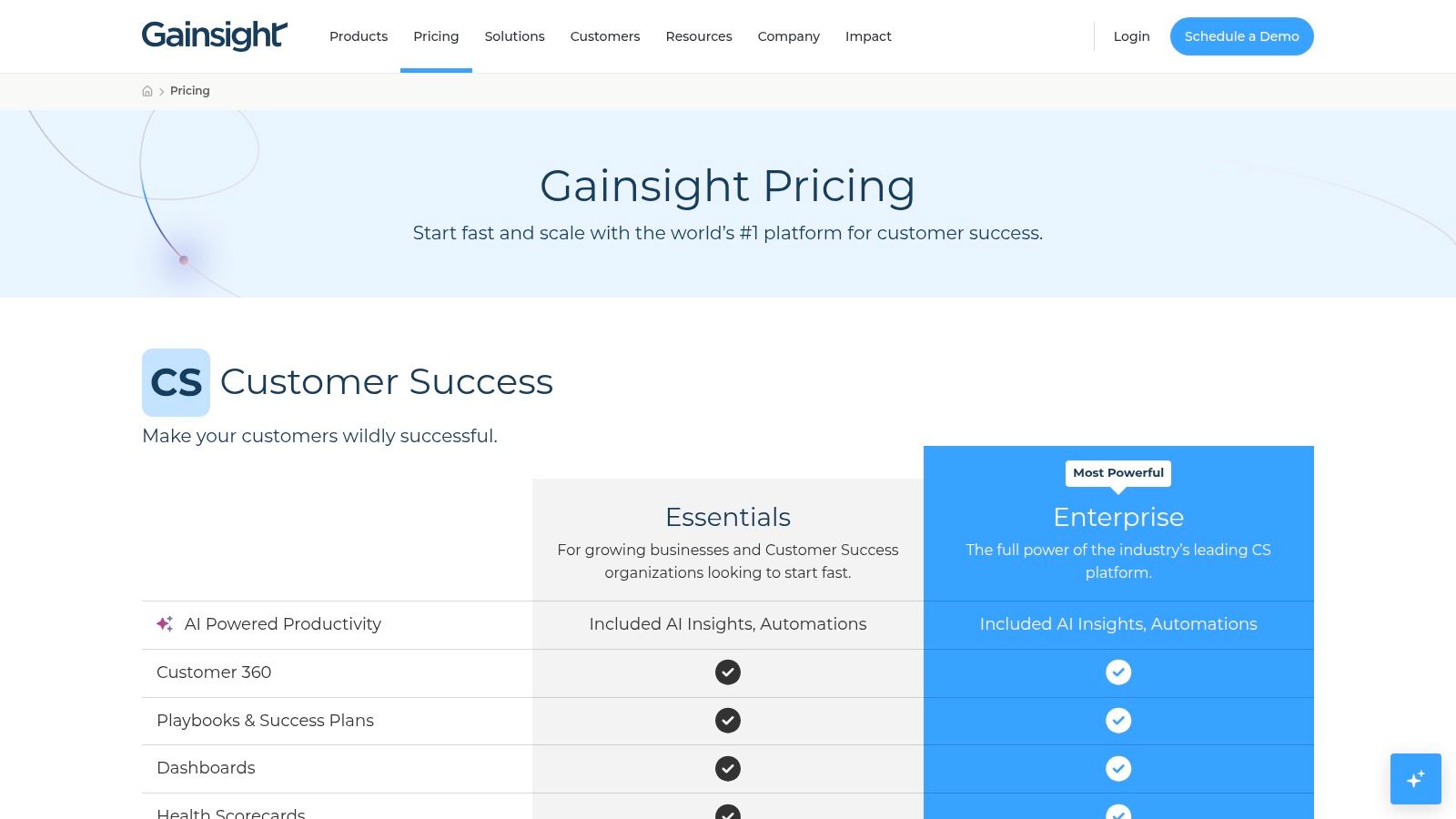
Why It's a Top PLG Tool
Gainsight PX excels at connecting product adoption to revenue outcomes like renewals and upsells. A product manager can track feature adoption for a key account, and if usage dips, it can automatically trigger a task for the Customer Success Manager in Gainsight CS to reach out. This closed-loop system ensures that product insights are not just observed but acted upon, directly supporting expansion and renewal workflows critical for mature PLG models.
Key Features & Pricing
| Feature | Description | Availability |
|---|---|---|
| Product Analytics | Connects user behavior analytics directly to customer health scores and account data. | Included in Platform |
| In-app Engagements | Build and deploy in-app guides, dialogs, and knowledge bots without code. | Included in Platform |
| Feedback & Surveys | Collect user feedback and NPS scores directly within the product experience. | Included in Platform |
| CSM Integration | Natively links product usage data to Customer Success playbooks and workflows. | Included in Platform |
- Pros: Seamlessly bridges the gap between Product and Customer Success teams. Its governance and reporting features are built for enterprise-scale operations. It is highly effective for managing expansion and renewal motions.
- Cons: Pricing is available only upon request, which can be a barrier for initial evaluation. The platform's extensive breadth may require significant stakeholder alignment to implement effectively.
Website: https://www.gainsight.com/pricing/?utm_source=openai
8. LaunchDarkly
LaunchDarkly is the industry-leading feature management platform that empowers teams to control their entire software release cycle. It separates code deployment from feature release, allowing for safe, targeted, and data-driven rollouts. This control is critical for product-led growth, as it enables teams to test new features with specific user segments, run beta programs, and iterate on the product experience without the risk of a full-scale deployment.
The platform is built around the concept of feature flags, which act as on/off switches for functionality within your application. This core capability allows product managers and engineers to manage the feature lifecycle from development to launch and beyond. By wrapping new code in a feature flag, you can ship it to production while keeping it hidden, then gradually release it to users based on attributes like company size, location, or early adopter status.
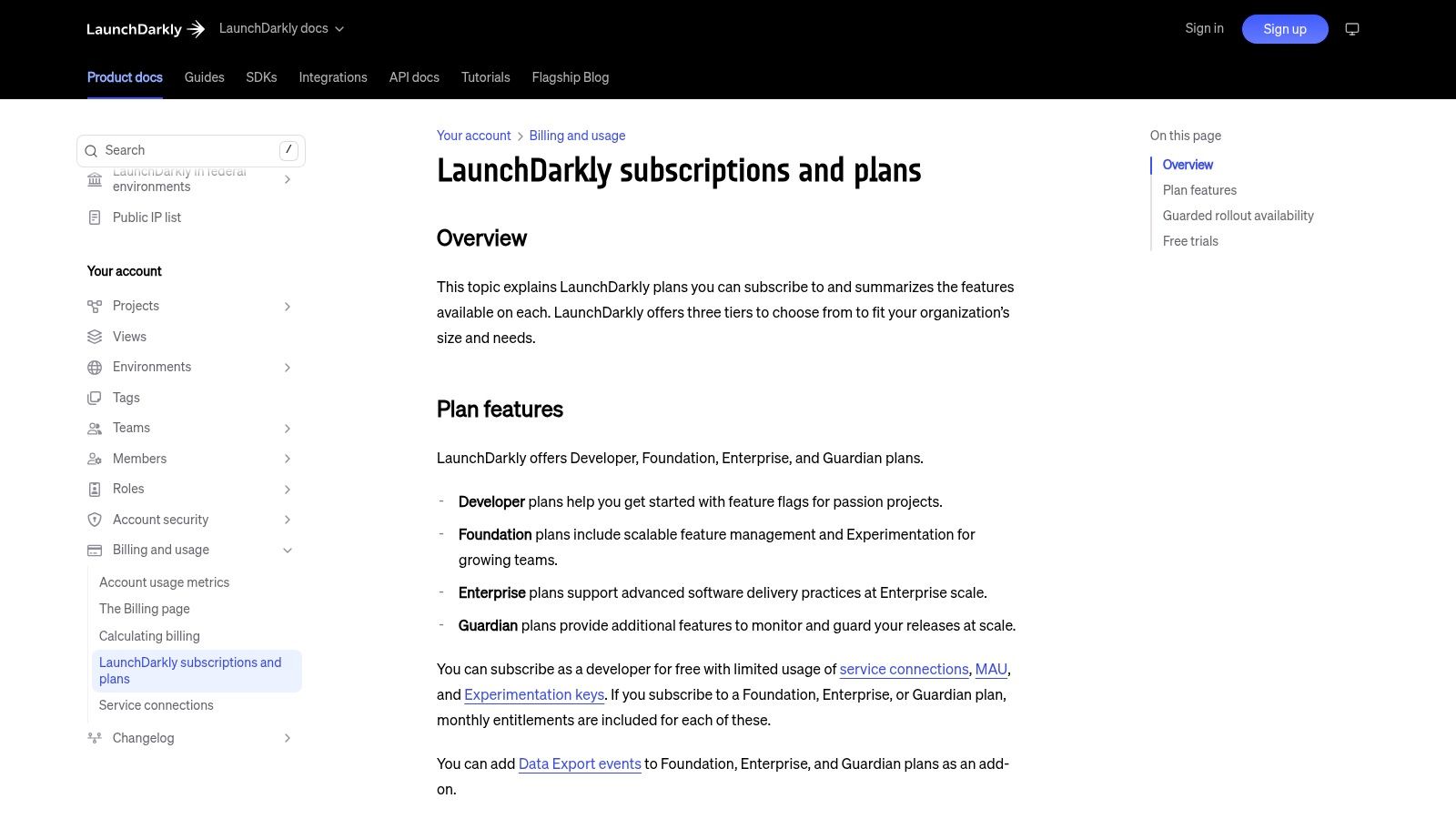
Why It's a Top PLG Tool
LaunchDarkly's power as a PLG tool lies in its ability to de-risk innovation and enable product-led experimentation at scale. A PLG team can launch a new premium feature exclusively to a cohort of highly engaged users on a free plan to test conversion and gather feedback. This targeted release provides valuable data before a full rollout, ensuring development resources are aligned with features that drive real user value and revenue.
Key Features & Pricing
| Feature | Description | Availability |
|---|---|---|
| Feature Flags | Robust flags with targeting rules, percentage rollouts, and scheduling. | All Plans |
| Experimentation | Run A/B/n tests on features to measure impact on key business metrics. | Foundation & Enterprise |
| SDKs | Comprehensive SDKs for nearly every major programming language and framework. | All Plans |
| Enterprise Governance | Advanced controls including audit logs, role-based access, and approvals. | Enterprise & Guardian |
- Pros: It is a highly reliable and scalable platform with strong documentation and a free Developer tier to get started. Its enterprise-grade controls are a major benefit.
- Cons: Pricing for paid tiers is not fully public, requiring a sales conversation. Non-engineering stakeholders may need some education to fully grasp the platform's potential.
Website: https://launchdarkly.com/docs/home/account/plans?utm_source=openai
9. Optimizely
Optimizely is a mature experimentation and digital experience platform renowned for its powerful A/B testing and feature management capabilities. It empowers product and marketing teams to validate changes, personalize user experiences, and de-risk feature rollouts through controlled experimentation. By providing a robust framework for testing hypotheses on live traffic, it has become an essential tool for data-driven product led growth strategies.
The platform distinguishes itself by offering both client-side (Web Experimentation) and server-side (Feature Experimentation) solutions. This dual capability allows teams to test simple visual changes on a website just as easily as they can test complex backend logic or algorithmic changes within an application, ensuring all product decisions are backed by empirical evidence.
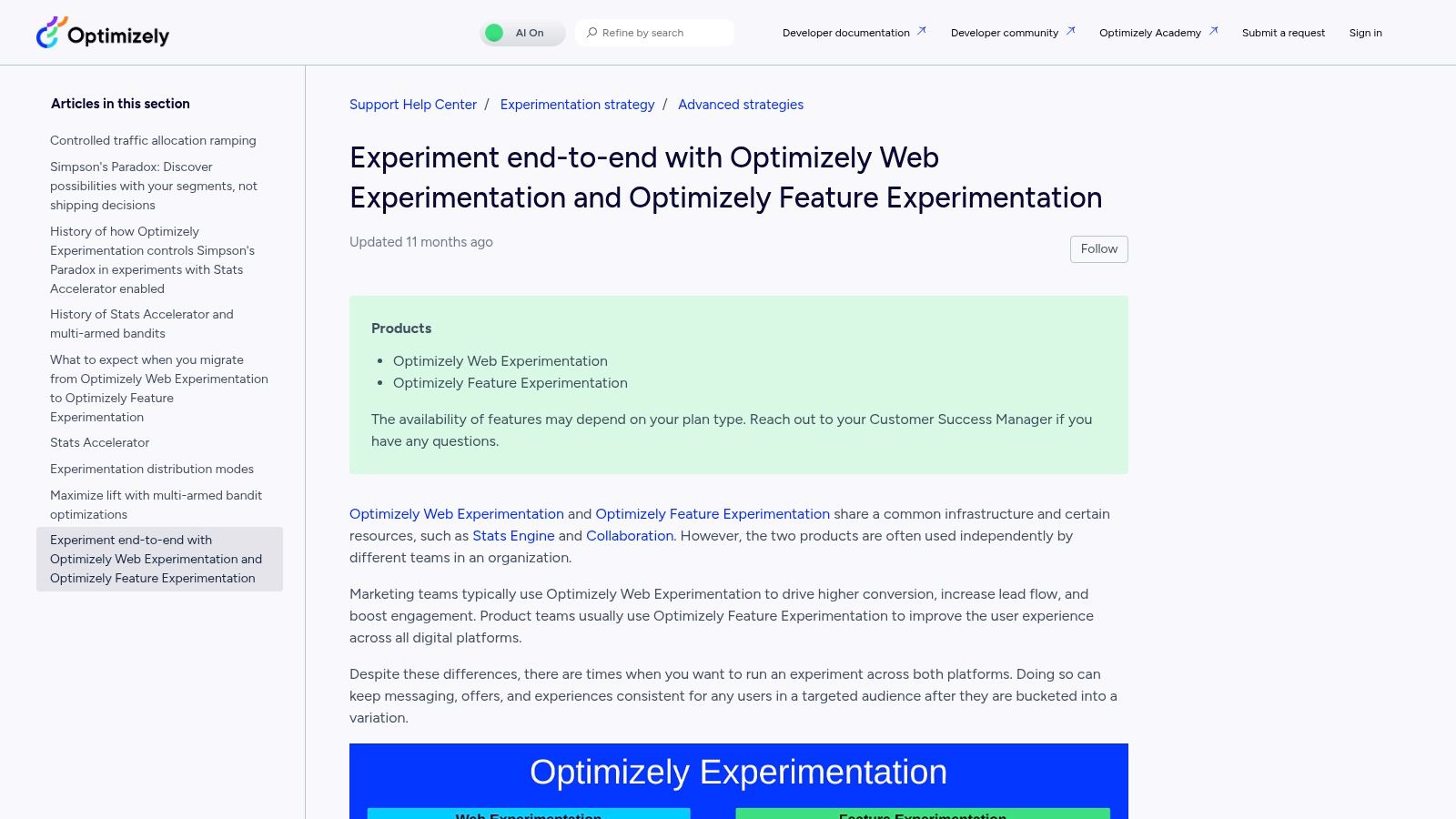
Why It's a Top PLG Tool
Optimizely's core value in a PLG context is its ability to directly measure the impact of product changes on key user behaviors and business metrics. A product team can use it to test a new onboarding flow for a specific user segment, measure its effect on activation rates, and confidently roll out the winning variation. This continuous loop of hypothesis, testing, and learning is fundamental to optimizing a self-serve product experience.
Key Features & Pricing
| Feature | Description | Availability |
|---|---|---|
| A/B/n & Multichannel Testing | Run experiments on web, mobile, and other digital channels. | Quote-based |
| Feature Experimentation | Server-side tools for testing features and managing releases (rollouts). | Quote-based |
| Personalization | Deliver targeted experiences to specific audience segments based on behavior. | Quote-based |
| Enterprise Integrations | Connects with a wide array of analytics, data, and marketing platforms. | Quote-based |
- Pros: Deep, enterprise-grade experimentation capabilities suitable for high-traffic, high-stakes testing. The platform's ecosystem and support are very strong.
- Cons: Pricing is not publicly listed and is quote-based, which can be a barrier for smaller teams. The platform's extensive features can be overkill for startups with simple testing needs.
10. Hotjar
Hotjar is a leading behavior analytics and feedback platform that provides a qualitative layer of insight into how users experience a website or product. It combines heatmaps, session recordings, and on-site surveys to reveal the "why" behind user actions. This makes it one of the most accessible product led growth tools for understanding user friction and discovering opportunities for improvement.
The platform's core value lies in its simplicity and visual approach to data. Instead of just looking at numbers in a chart, teams can watch actual user sessions to see where they get stuck, what they click on, and what they ignore. This direct window into the user experience is invaluable for PLG teams focused on optimizing onboarding flows, improving feature adoption, and reducing churn.
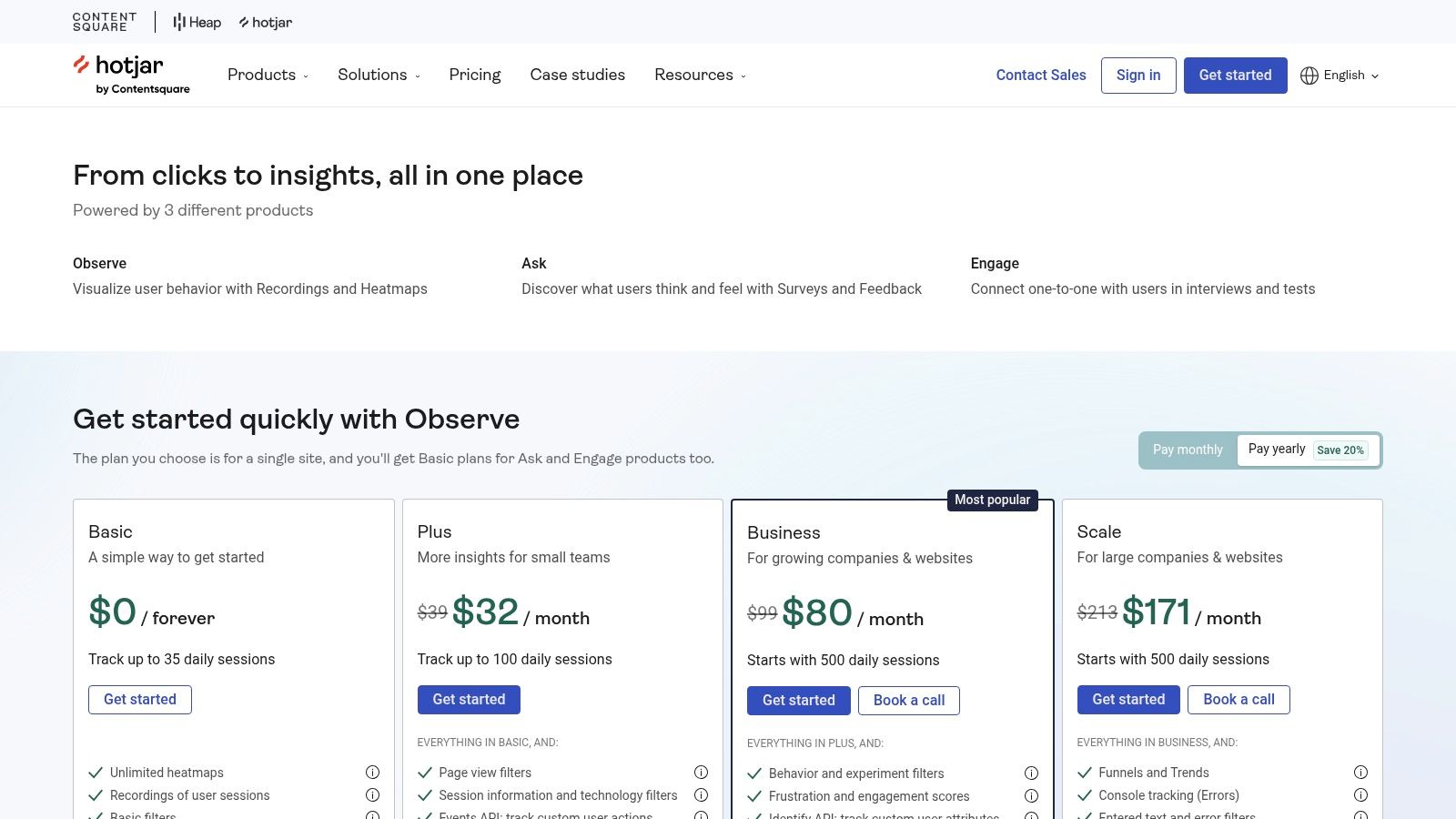
Why It's a Top PLG Tool
Hotjar excels at helping teams build empathy and validate quantitative data with qualitative insights. For example, if your product analytics tool shows a significant drop-off at a specific step in your sign-up process, Hotjar's session recordings can show you exactly what users are doing at that point. You might discover a confusing UI element or a frustrating bug that wasn't apparent from the data alone.
Key Features & Pricing
| Feature | Description | Availability |
|---|---|---|
| Session Replay & Heatmaps | Watch recordings of user sessions and see visual click, move, and scroll maps. | Free & Paid Plans |
| Funnels & Dashboards | Track user journeys through key flows and visualize core metrics. | Free & Paid Plans |
| Surveys & Feedback | Collect direct user feedback with on-site surveys and a feedback widget. | Free & Paid Plans |
| Integrations | Connects with Google Analytics, Mixpanel, Jira, Slack, and more. | All Plans |
- Pros: It is incredibly easy and fast to set up, often taking just minutes. The free plan is genuinely useful for early-stage exploration, and its pricing offers good value for small to mid-sized businesses.
- Cons: It is not a replacement for a dedicated product analytics tool like Mixpanel or Amplitude. Data limits on lower-tier plans can be restrictive for high-traffic sites.
For those evaluating user experience tools, if you're exploring other options for product experience and user behavior analytics, you might find valuable insights in articles discussing the best Hotjar alternatives.
Website: https://www.hotjar.com/pricing?utm_source=openai
11. FullStory
FullStory is a digital experience intelligence (DXI) platform that combines high-fidelity session replay with product analytics to help teams understand and improve the user journey. It captures nearly every user interaction, allowing product, engineering, and support teams to see exactly what users are experiencing, identify friction points, and diagnose bugs with pixel-perfect accuracy. This qualitative-meets-quantitative approach makes it one of the most powerful product led growth tools for understanding the "why" behind user behavior.
The platform excels at providing context that traditional analytics often miss. Instead of just seeing a drop-off in a funnel, teams can watch the corresponding user sessions to see the rage clicks, dead clicks, and confusing UI elements that caused frustration. This direct insight is invaluable for PLG, as it helps teams prioritize fixes and experiments that will have the most significant impact on user activation and retention.
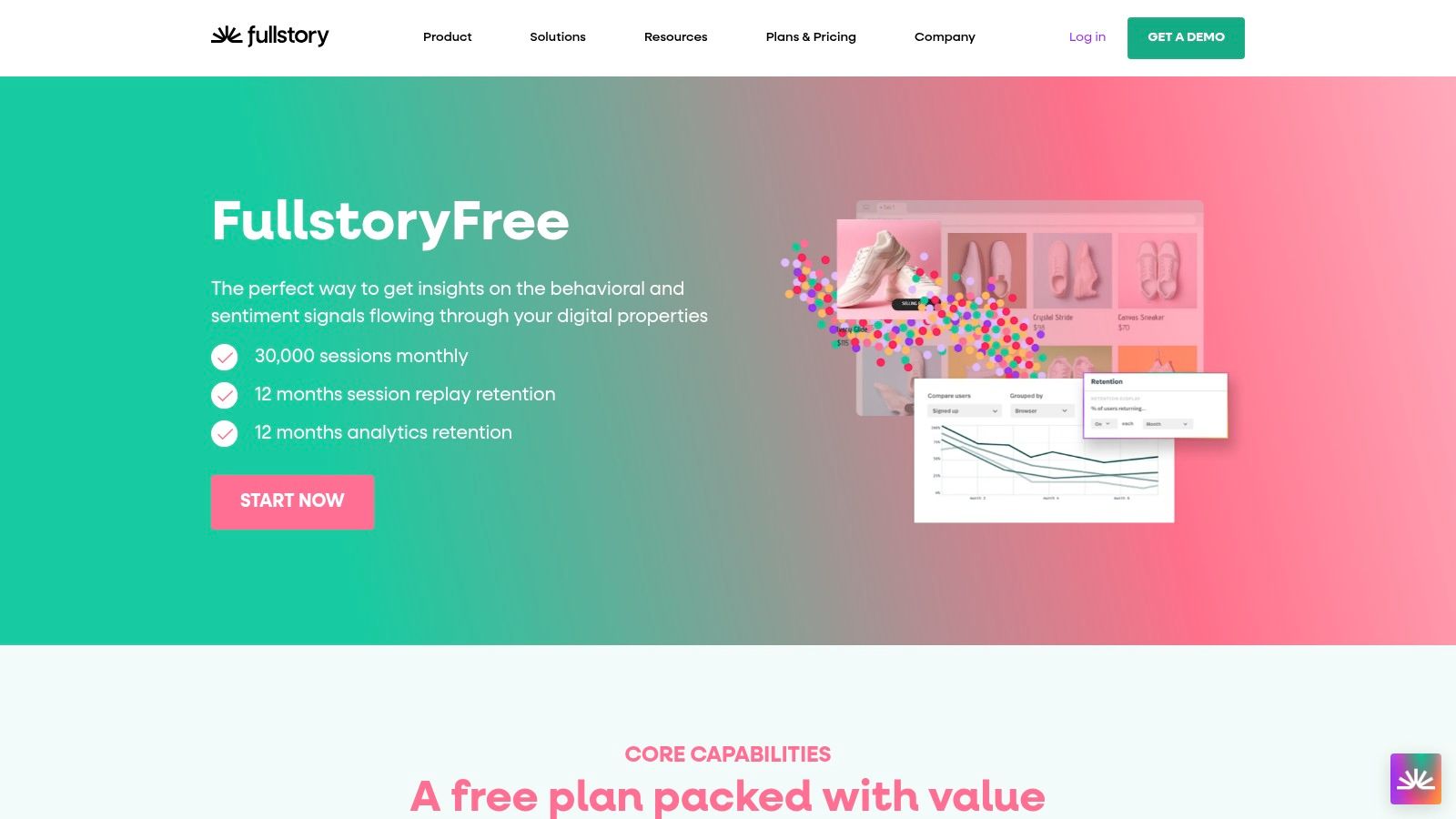
Why It's a Top PLG Tool
FullStory's strength is its ability to provide irrefutable evidence of user friction. A product manager can filter for sessions where users encountered an error or abandoned a critical workflow, watch the replays to understand the root cause, and share the video evidence with engineering to expedite a solution. This eliminates guesswork and ensures that product improvements are based on real, observable user struggles, creating a faster path to a frictionless, value-driven product experience.
Key Features & Pricing
| Feature | Description | Availability |
|---|---|---|
| Session Replay | High-fidelity, privacy-first session replays that are fully indexed and searchable. | Free & Paid Plans |
| Digital Experience Intelligence | Automatically surfaces frustration signals like rage clicks, dead clicks, and errors. | Free & Paid Plans |
| Product Analytics | Funnels, metrics, and dashboards to quantify user behavior and trends. | Paid Plans |
| Mobile SDKs | Full support for capturing user experiences on native iOS and Android applications. | Paid Plans |
- Pros: The session replay quality and searchable data are best-in-class. It is incredibly helpful for conducting root-cause analysis of conversion drop-offs.
- Cons: The platform can be premium-priced at scale. Setting up data capture and ensuring PII governance requires careful, deliberate implementation.
Website: https://www.fullstory.com/FullstoryFree/?utm_source=openai
12. G2
G2 is a comprehensive software marketplace and review platform, acting as a crucial discovery engine for teams evaluating product led growth tools. Instead of being a PLG tool itself, it aggregates user-generated reviews, real-time satisfaction scores, and detailed feature comparisons across hundreds of categories, from product analytics to digital adoption. This makes it an indispensable resource for building a PLG tech stack.
The platform allows product teams to move beyond vendor marketing claims and see how tools actually perform in real-world scenarios. Users can filter solutions by company size, specific features, and integration capabilities, making it easier to create a shortlist of vendors that fit their exact needs. This peer-validated approach helps de-risk technology investments, a key consideration for fast-moving PLG companies.
Why It's a Top PLG Resource
G2’s strength is its crowd-sourced data, which provides an unbiased look at the market landscape. A product manager can use it to identify the top-rated digital adoption platforms for SMBs, read detailed reviews from peers, and even directly compare the feature sets of the top three contenders side-by-side. This process streamlines the research phase, helping teams make faster, more informed decisions about the tools that will power their growth.
Key Features & Pricing
| Feature | Description | Availability |
|---|---|---|
| User Reviews | Authentic, verified reviews from real software users. | Free to Access |
| Category Grids | Visual market comparisons showing leaders, contenders, and niche players. | Free to Access |
| Feature & Price Comparison | Side-by-side comparisons of tool features, pricing, and integrations. | Free to Access |
| Vendor Shortlisting | Tools to save, compare, and shortlist potential software vendors. | Free to Access |
- Pros: Its broad coverage across nearly every PLG tool category is unmatched. The ability to filter by company segment (SMB, Mid-Market, Enterprise) is highly valuable.
- Cons: Ratings can sometimes be influenced by vendor-led review campaigns. Users must still visit vendor sites to validate specific pricing and feature availability.
G2 is a free resource for buyers, with its business model based on vendors paying for enhanced profiles and lead-generation tools.
Website: https://www.g2.com/categories/product-analytics?utm_source=openai
Product-Led Growth Tools Comparison
| Product | Core Features / Capabilities | User Experience / Quality ★ | Value & Pricing 💰 | Target Audience 👥 | Unique Selling Points / Highlights ✨ |
|---|---|---|---|---|---|
| 🏆 Refgrow | Native affiliate dashboard, Referral Exchange, flexible commissions, API, Stripe/LemonSqueezy integration | ★★★★★ | $9–19/mo, 0% fees, unlimited earnings | SaaS products, startups to marketplaces | One line code embed, 0% commission, instant affiliate network ✨ |
| Amplitude | Product analytics, experimentation, feature flags, session replay | ★★★★☆ | Free tier; clear paid plans | PLG teams, startups to enterprise | Unified analytics + experimentation |
| Mixpanel | Event-based analytics, AI query builder, session replay | ★★★★☆ | Usage-based, free 1M events | PLG product teams, non-analysts | Transparent pricing, AI-assisted queries |
| PostHog | Product analytics, session replay, feature flags, self-hosting option | ★★★★☆ | Generous free, usage-based | Developers, companies wanting open-source | All-in-one, open-source, self-host option |
| Pendo | In-app guides, product analytics, NPS, surveys | ★★★★☆ | Limited free, quote-based | Enterprise PLG, mobile & web apps | No-code guides + analytics + governance |
| Appcues | No-code onboarding flows, targeting, A/B tests | ★★★★ | Tailored pricing by MAU | Product teams, PLG adopters | Fast onboarding creation, strong targeting |
| Gainsight PX | Product analytics, in-app guides, customer success integration | ★★★★ | Request pricing | Enterprises, customer success & PLG | CS & product bridge, health-linked analytics |
| LaunchDarkly | Feature flags, targeted rollouts, experimentation | ★★★★☆ | Free dev tier, quote-based paid | Engineering teams, enterprises | Robust feature flagging and governance |
| Optimizely | A/B/n tests, personalization, rollouts | ★★★★☆ | Quote-based pricing | Large enterprises | Deep experimentation, high-scale suited |
| Hotjar | Session replay, heatmaps, funnels, surveys | ★★★☆☆ | Free plan, SMB/mid-market focus | SMBs, UX teams | Quick setup, strong free tier |
| FullStory | Session replay, product analytics, AI insights | ★★★★ | Free trial, premium priced | Enterprise UX and product teams | High-fidelity replay, AI-powered insights |
| G2 | Product comparisons, reviews, ratings | ★★★★ | Free access | Buyers, PLG tool seekers | Crowd-sourced reviews, segmentation filters |
Building Your Perfect PLG Stack
Navigating the expansive landscape of product-led growth tools can feel overwhelming, but the journey to building a powerful, user-centric growth engine is an investment in your company's future. Throughout this guide, we've explored a dozen powerful platforms, each designed to address specific friction points in the user journey. From deep-diving into user behavior with analytics tools like Amplitude and Mixpanel to crafting seamless onboarding experiences with Appcues and Pendo, the common thread is clear: understanding and empowering the user is paramount.
The core takeaway is that a successful PLG strategy isn't about adopting a single "magic bullet" tool. Instead, it's about strategically assembling a technology stack that provides a 360-degree view of the user experience. Your product analytics platform is the foundation, revealing the "what" and "where" of user actions. Layering on qualitative tools like Hotjar or FullStory then uncovers the "why," while feature flagging and A/B testing platforms like LaunchDarkly and Optimizely allow you to act on those insights with precision and control.
Key Considerations for Your PLG Tool Selection
As you begin the selection process, it's crucial to move beyond feature checklists and consider the holistic impact on your team and workflow. Remember, the best tool is the one your team will actually use.
Here are a few final factors to guide your decision-making:
- Integration is Non-Negotiable: A disconnected stack creates data silos and inefficient workflows. Prioritize tools that offer robust, native integrations with your existing systems, such as your CRM, data warehouse, and communication platforms. A well-integrated stack ensures that insights from one tool can seamlessly trigger actions in another.
- Scalability for the Future: Your needs today will not be your needs in two years. Evaluate a tool's ability to grow with you. Consider pricing models that scale fairly, performance under increasing data loads, and the platform’s roadmap for future features. Avoid getting locked into a solution you'll outgrow quickly.
- Team Skillset and Adoption: Who will be the primary users of these product-led growth tools? A highly technical, data-driven team might thrive with a complex platform like PostHog, while a product marketing team may prefer the user-friendly, no-code interface of a tool like Pendo. Choose a solution that empowers your team, not one that requires extensive, specialized training to become useful.
- Start with Your Biggest Problem: Don't try to solve every problem at once. Identify the most significant point of friction in your user journey right now. Is it user activation? Churn? Feature discovery? Select a tool that directly addresses that primary pain point first. Once you demonstrate value and see a return on investment, you can strategically expand your stack.
Your Next Steps to a Product-Led Future
Building the right PLG stack is an iterative process of learning, testing, and optimizing. It's not just about collecting data; it's about turning that data into a better product experience that drives acquisition, retention, and expansion. The tools we've covered are powerful enablers, but the true catalyst for growth is a deep-seated commitment to putting your product and its users at the very center of every decision you make.
Start small, focus on a critical business goal, and choose a tool that empowers you to take immediate, data-informed action. By thoughtfully selecting and implementing the right product-led growth tools, you equip your team with the insights and capabilities needed to build a product that doesn't just sell itself but also creates a loyal base of advocates.
Ready to amplify your user acquisition and turn your best customers into your most effective marketing channel? Refgrow provides a complete referral and affiliate marketing platform designed specifically for PLG companies, integrating seamlessly into your product to drive organic growth. Explore how you can build, manage, and scale your user-led growth programs at Refgrow.

